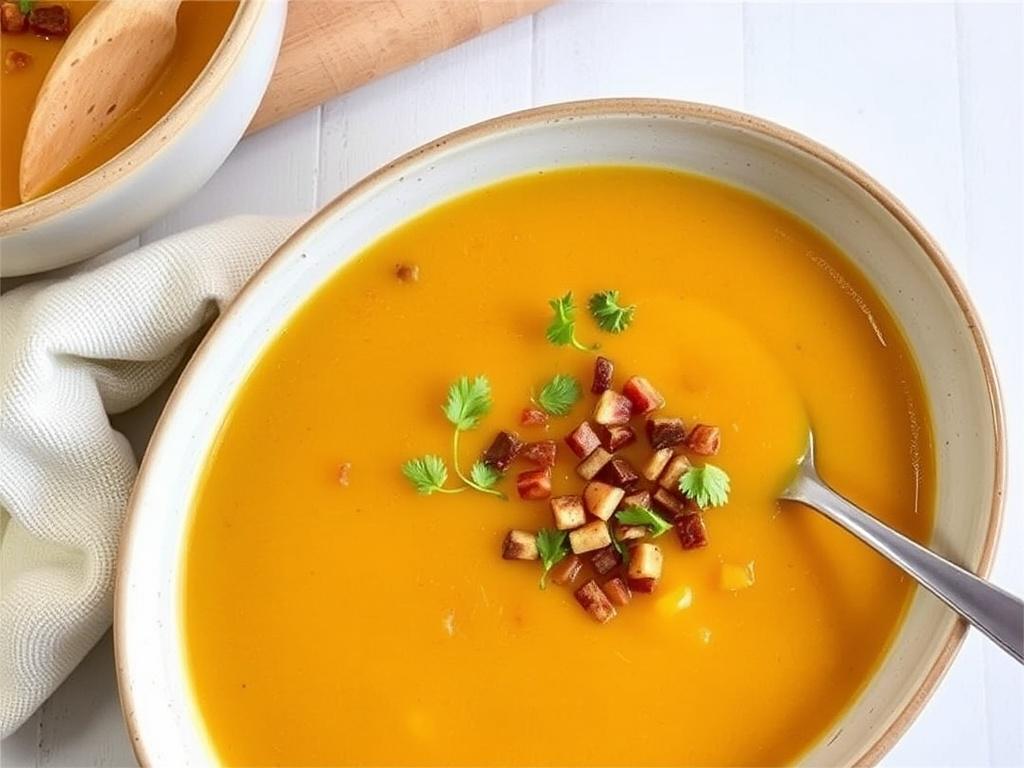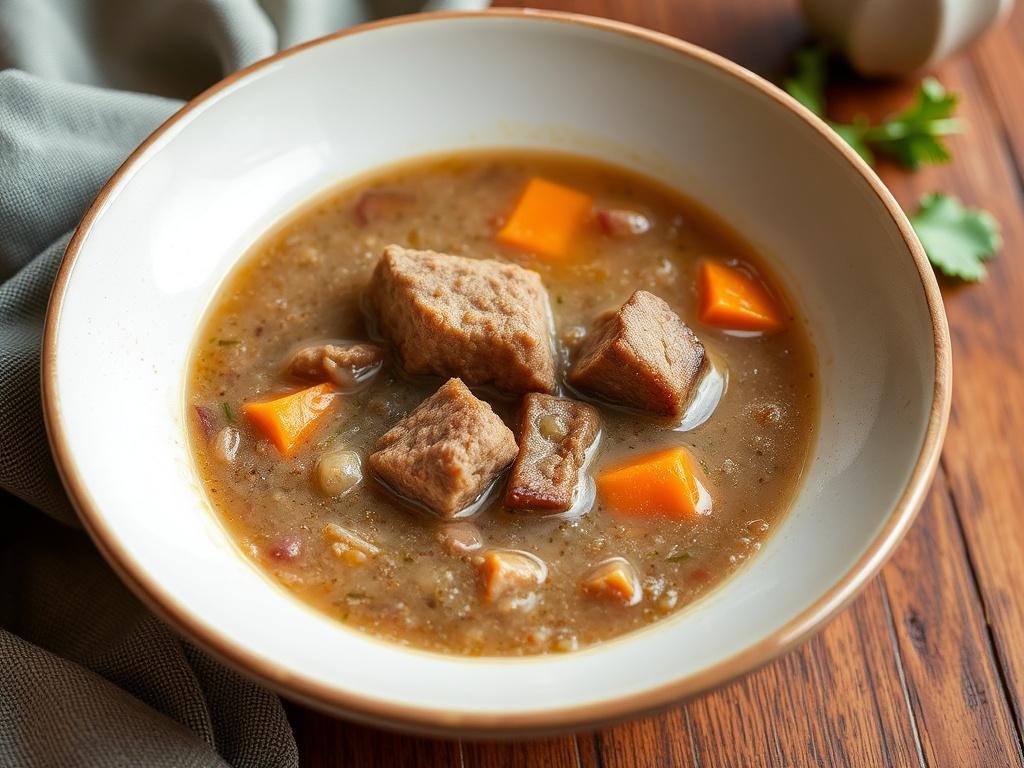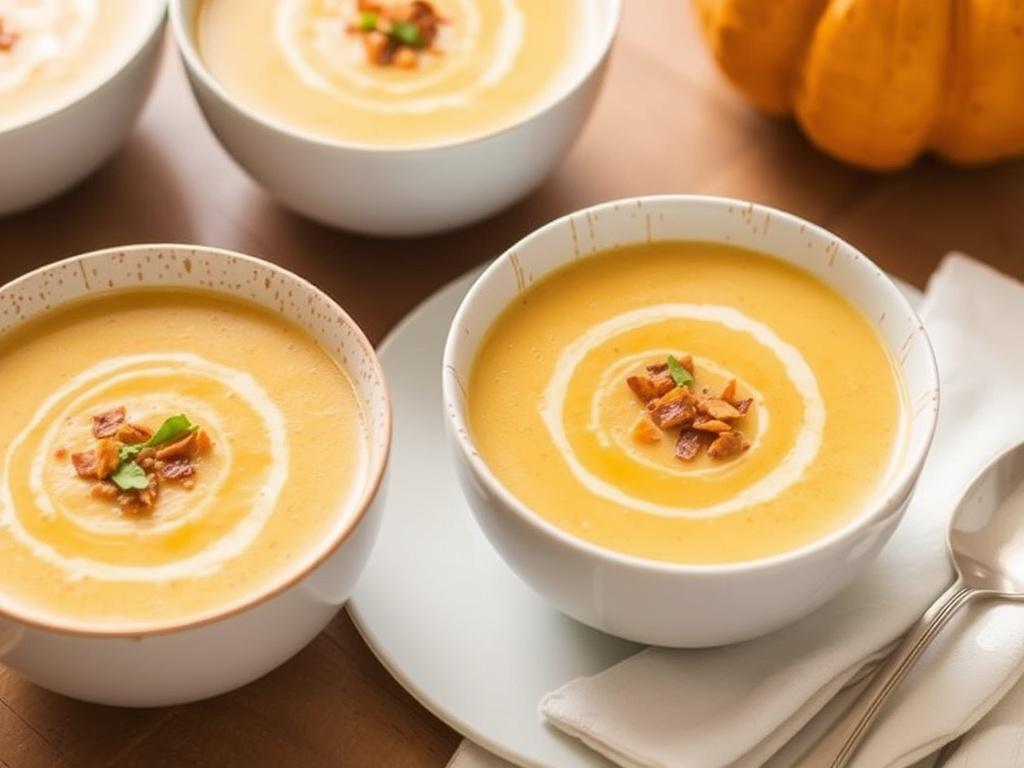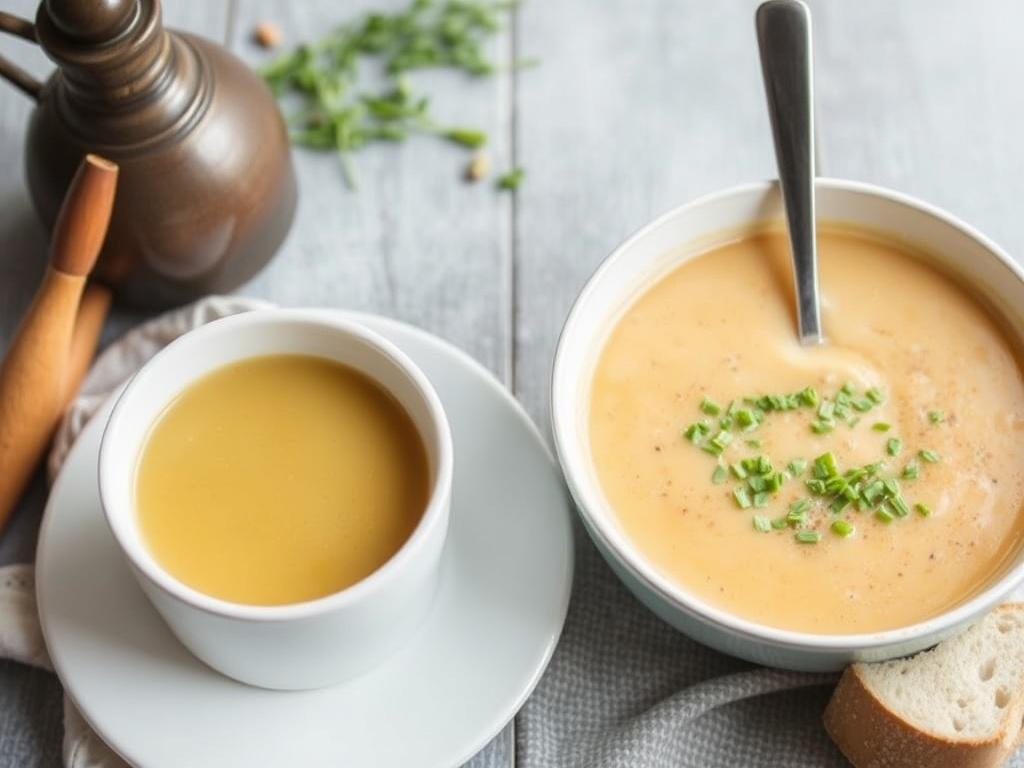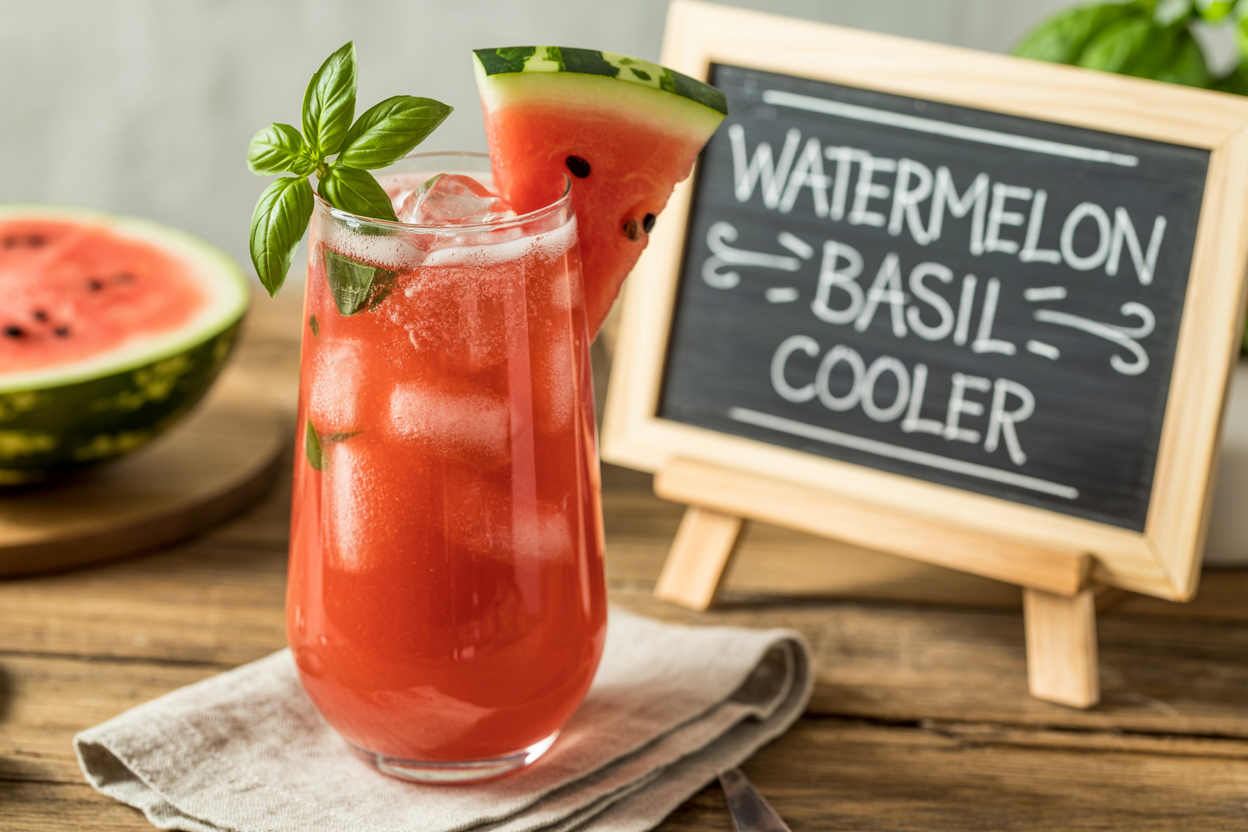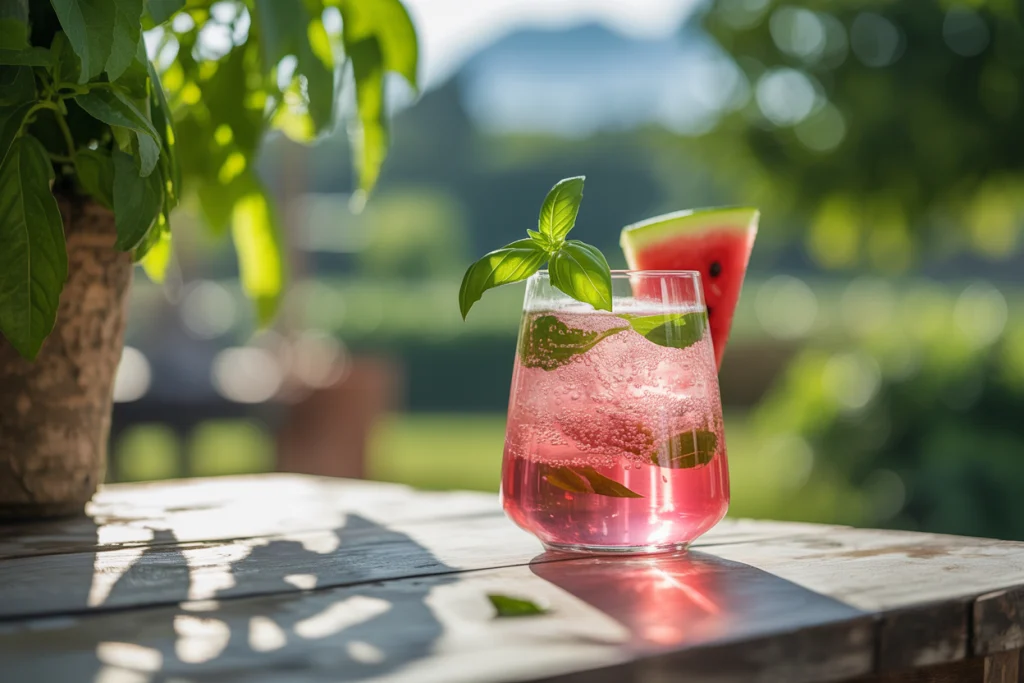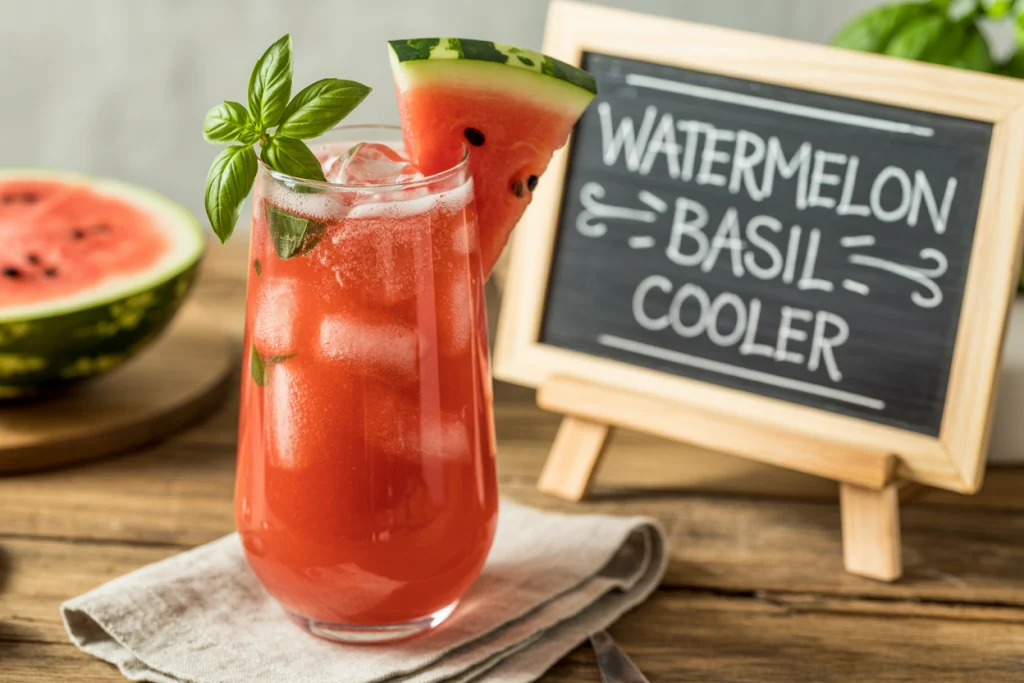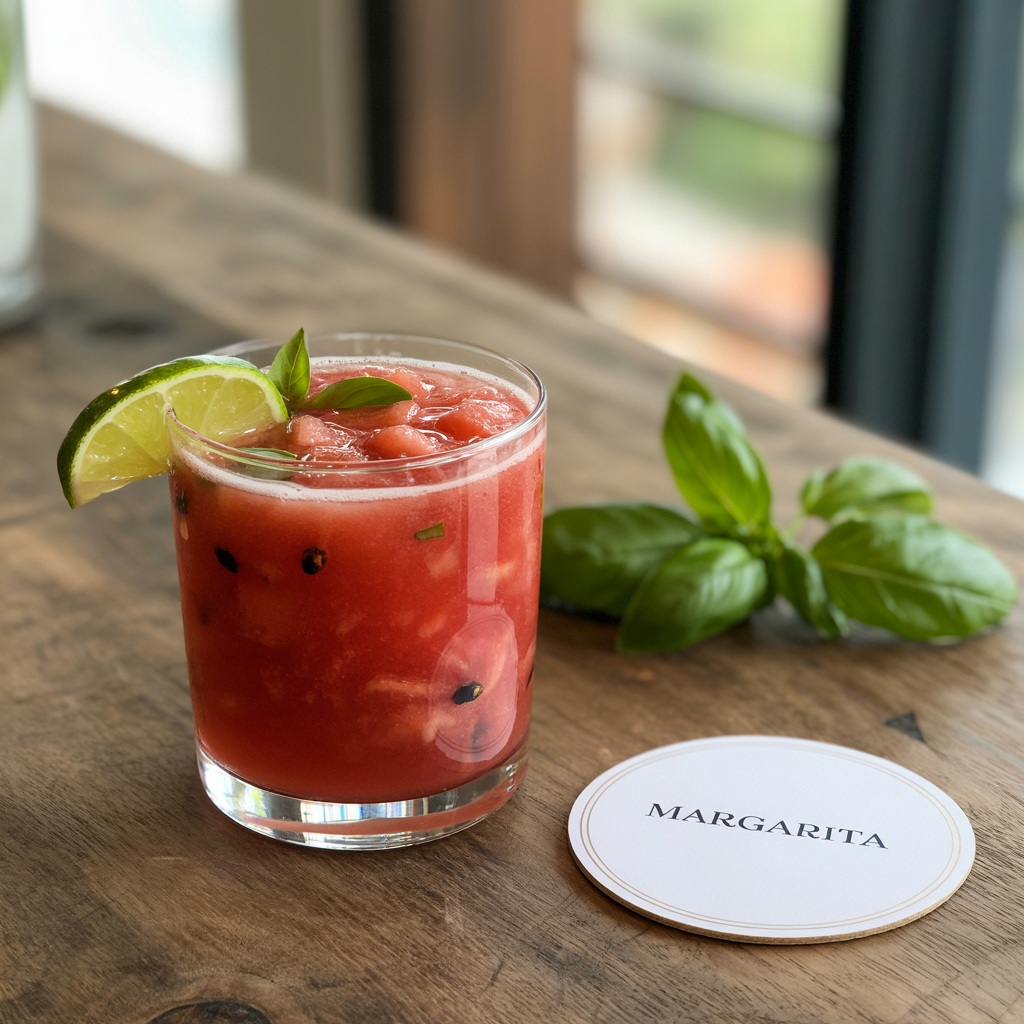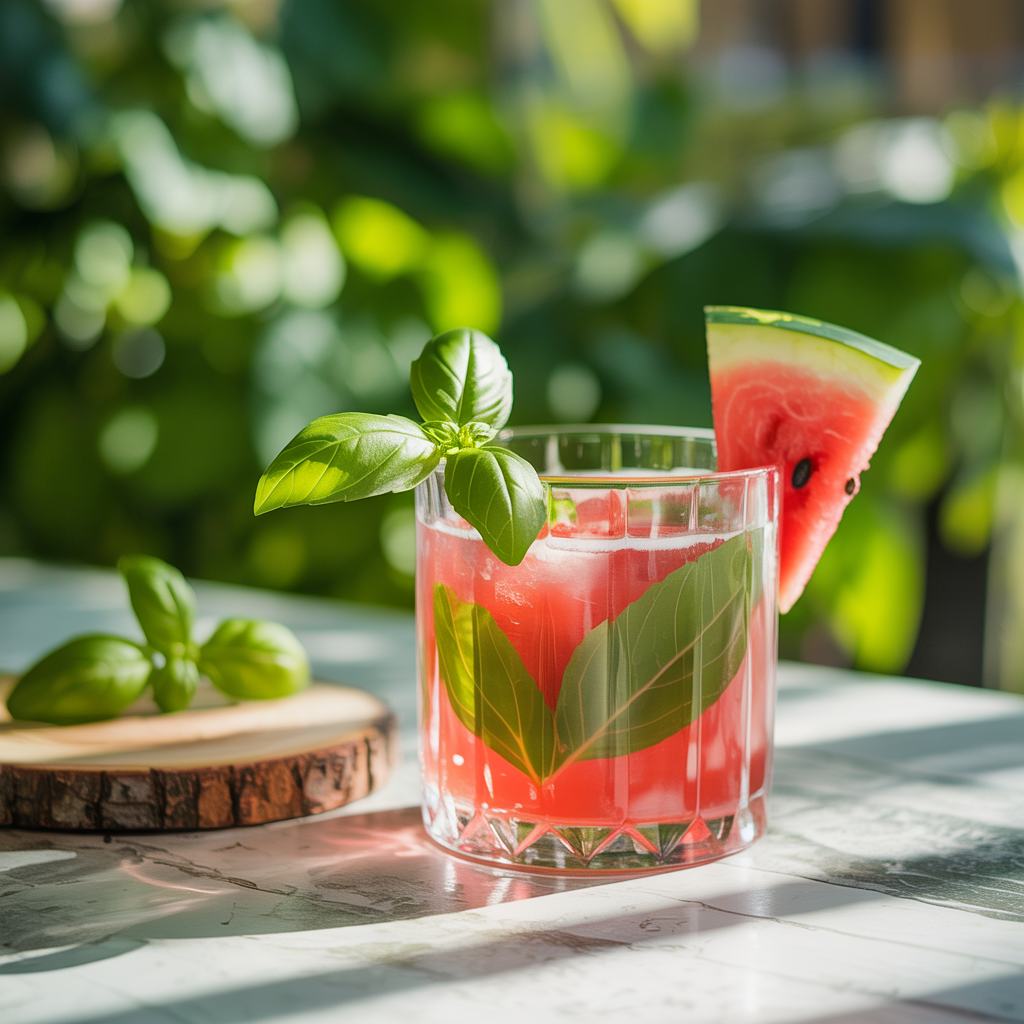Sunday Comfort: How to Make a Perfect Roast Chicken with Potatoes Every Time
There’s a reason a golden bird and a bed of browned tubers show up on so many family tables: the combination is simple, honest and deeply satisfying. In this article I’ll walk you through everything I’ve learned about turning a raw chicken and a few humble potatoes into a feast that looks impressive and tastes like slow, careful cooking. You’ll find practical techniques, ingredient choices, timing guides and flavor variations so you can adapt this to weeknights or a relaxed weekend meal. Read on and you’ll gain confidence in carving, resting, and coaxing the crispiest skin while keeping the meat juicy. By the end you’ll see how this one-pan roast can become a reliable centerpiece for dinners that deserve attention but not stress.
Why this combination works so well
White meat and golden potatoes complement each other in texture and flavor: the bird offers savory, lightly perfumed flesh while the spuds soak up pan juices and caramelize at the edges. When you roast them together the potatoes benefit from rendered fat and herbs, which creates a depth of flavor impossible to achieve when they’re cooked separately. There’s also a practical logic: both components thrive at similar oven temperatures, which simplifies timing and cleanup. Finally, the dish scales easily — a small joint for two, or a large bird for a gathering — and adapts to different cuisines depending on the aromatics you add. This versatility is why many cooks turn to it as a reliable weeknight solution or a centerpiece for casual entertaining.
Choosing the bird and the spuds
Picking the right chicken makes all the difference. For most home cooks a 3–4 pound (1.4–1.8 kg) whole chicken is ideal: large enough to feed several people yet small enough to cook evenly. Free-range or pasture-raised birds often deliver better texture and flavor, but a conventional chicken can turn out delicious if it’s fresh. Consider whether you want bone-in and skin-on — these elements retain moisture and create the caramelized skin most of us crave. If time is short, spatchcocking (butterflying) the bird reduces roasting time and promotes even browning.
Potatoes are not interchangeable; their starch content changes how they roast. Waxy varieties like Yukon Gold hold their shape and develop crisp edges while staying creamy inside, which makes them my go-to for roasting alongside poultry. Russets will crisp beautifully but can fall apart if left to stew in juices, so cut them larger if you prefer a Russet. If you want a mix of textures, combine a waxy potato with a floury one for contrast. Size matters too: aim for even pieces so everything finishes at the same time.
Ingredients and equipment you’ll need
Good technique starts with straightforward ingredients. At minimum you need a whole chicken, a kilo or so of potatoes, olive oil or rendered butter, salt, black pepper, and one or two aromatics such as garlic, lemon, or fresh herbs. From there you can build flavor with smoked paprika, thyme, rosemary, or a mustard rub. Freshness matters for herbs and citrus; dried versions work, but use them sparingly to avoid overpowering the dish. A versatile approach is to season boldly on the skin and more gently on the potatoes, allowing each element to express itself without clashing.
Equipment is simple but worth investing in the right pieces. A sturdy roasting pan with low sides encourages airflow and browning; a rack can keep the bird elevated so air circulates under the skin. A meat thermometer is indispensable — it removes guesswork and prevents overcooking. If you spatchcock, a sharp chef’s knife or poultry shears are essential. Finally, a wide ovenproof skillet or sheet pan makes cleanup easier and helps the potatoes crisp uniformly under high heat.
Ingredients table
Below is a compact ingredients guide with suggested quantities and optional swaps to personalize the flavor profile. Use it as a starting point; adjust salt and aromatics to taste.
| Ingredient | Quantity (serves 4) | Alternatives / Notes |
|---|---|---|
| Whole chicken | 3–4 lb (1.4–1.8 kg) | Spatchcock for faster cook; bone-in parts if preferred |
| Potatoes | 1–1.5 kg | Yukon Gold or a mix of waxy and floury |
| Olive oil / Butter | 2–4 tbsp | Use clarified butter for a richer flavor |
| Garlic, herbs, lemon | 2–4 cloves; handful of herbs; 1 lemon | Rosemary, thyme, sage are all good choices |
| Salt & pepper | To taste | Sea salt or kosher salt for better control |
Step-by-step method that actually works
Start with the chicken at room temperature; an hour out of the fridge helps the meat cook evenly. Pat the skin dry with paper towels — moisture is the enemy of crispness — then season the cavity with coarse salt and a few aromatics like a halved lemon and a couple of smashed garlic cloves. Tuck the wing tips under and, if you’re not spatchcocking, tie the legs with kitchen twine to encourage even roasting. For the skin, rub a mixture of oil and seasoning all over, getting into the crevices but allowing the skin surface to stay relatively dry so it browns properly.
Prepare the potatoes while the bird relaxes: wash and cut into even chunks, then toss with a little oil, salt, pepper and herbs. Spread them in a single layer in the roasting pan, leaving space for airflow so they crisp rather than steam. Place the chicken on top of the potatoes or on a rack above them depending on whether you want the tubers to bathe in juices or to stay firmer. Slide the pan into a preheated oven — a common approach is 220°C (425°F) for the first 15–20 minutes to kick-start browning, then reduce to around 190–200°C (375–400°F) until the chicken reaches the safe internal temperature.
Concise recipe steps
An ordered list helps keep the process clear when you’re cooking. Follow these steps and consult the timing table later for exact minutes based on weight.
- Bring chicken to room temperature; preheat oven and prepare potatoes.
- Dry and season the bird; stuff cavity with aromatics if desired.
- Toss potatoes with oil and seasonings; arrange in pan.
- Roast at high heat briefly, then lower temperature and continue until done.
- Rest the chicken before carving; finish potatoes under the broiler if needed.
Seasoning ideas and flavor profiles
Seasoning isn’t just salt and pepper — it’s your chance to steer the dish toward different culinary territories. Classic Mediterranean flavors use lemon, garlic and oregano or thyme for a bright, herbal profile. A North African twist brings cumin, smoked paprika and preserved lemon into play. For an autumnal scent, rub the bird with butter blended with sage and roasted garlic. Mustard, honey and rosemary create a sticky, savory-sweet glaze that pairs beautifully with roasted potatoes. Choosing one clear flavor direction prevents the dish from becoming muddled and ensures that both the chicken and spuds sing in harmony.
Herbs can be used fresh or dried; fresh herbs give vibrancy when added near the end, while dried herbs can be rubbed on at the beginning for deeper penetration. Spice rubs should be balanced with fat — oil or butter helps spices adhere and bloom in the heat. If you like a crust with some sweetness, a light sprinkle of brown sugar or honey in the last 10–15 minutes of roasting will caramelize the skin without burning. Taste as you go with simple trials — a pinch of smoked paprika on a potato slice or a smear of mustard on a small chicken breast — to find the combination you prefer.
Timing and temperature: the numbers you need
Cooking time varies with weight and whether you spatchcock. The safest and most reliable method is to use an instant-read thermometer: the thickest part of the thigh should reach 74°C (165°F). As a guideline, allow about 20 minutes per pound (45 minutes per kilogram) at a moderate oven temperature after the initial high-heat period, but treat this as a starting point rather than a rule. Keep in mind altitude, oven accuracy and whether you’re using convection settings — these factors affect timing. Checking early and often near the anticipated finish time prevents drying out and ensures juicy results.
While the chicken cooks, the potatoes should brown and develop crisp edges. If they aren’t browning fast enough, increase heat briefly or move the pan onto a higher rack, watching carefully so they don’t burn. If the bird is done before the potatoes, remove it, tent with foil and let it rest; the carryover heat will lift the chicken a few degrees while the potatoes finish. Conversely, if the potatoes are done too early, remove them and keep warm under foil. Flexibility and staging are the secrets to synchronized finishing.
Timing reference table
Use this table as a quick reference, then rely on your thermometer for the final decision.
| Chicken weight | Estimated roasting time after initial high heat | Internal temp target |
|---|---|---|
| 2–3 lb (0.9–1.4 kg) | 40–60 minutes | 74°C / 165°F |
| 3–4 lb (1.4–1.8 kg) | 60–80 minutes | 74°C / 165°F |
| 4–5 lb (1.8–2.3 kg) | 80–100 minutes | 74°C / 165°F |
Tips for crispy skin and fluffy potatoes
Crisp skin is a product of dryness, heat and minimal interference. Patting the skin thoroughly with paper towels removes surface moisture that would otherwise steam the skin instead of browning it. Coating the bird lightly with oil or clarified butter helps heat conduct evenly and promotes the Maillard reaction that produces brown, savory flavors. Avoid a heavy saucing early in the roast; apply glazes near the end to preserve crispness. Finally, resting the bird uncovered briefly before serving helps the skin retain texture while the meat redistributes its juices.
For potatoes, preheating the pan or using a hot roasting surface jump-starts crust formation. Give the cut potatoes enough space to breathe; overcrowding causes steaming rather than roasting. Parboiling is an optional technique if you want ultra-fluffy interiors — a short simmer before dabbing dry and finishing in the oven gives a tender inside and a perfectly puckered exterior. Tossing with a little flour or semolina before roasting can add extra crunch, but I reserve that trick for when I want an especially textural contrast.
Vegetables and side options beyond potatoes
While potatoes are traditional, you can roast other vegetables alongside the chicken for variety and color. Carrots, parsnips and fennel add sweetness and aromatic depth; Brussels sprouts and shallots provide savory bite. Harder root vegetables need longer to cook, so cut them slightly smaller than the potatoes or parboil briefly. If you add softer veg like zucchini, wait until the last 20–25 minutes so they don’t disintegrate. The goal is to create a balanced pan where each item finishes at the same time with complementary textures.
If you want a lighter accompaniment than starch, a citrusy salad or simple buttered greens refreshes the palate and offsets the roast’s richness. Spoon some of the pan juices over a bed of greens for a quick warm dressing. For a heartier menu, add roasted garlic mashed potatoes or a grain like farro tossed with herbs and lemon. The key is coherence: match the intensity of flavors so the sides support the bird rather than compete with it.
Quick side dish list
Here are a few reliable pairings that match different cooking moods. Choose one or two to round out the meal easily.
- Simple lemon-parsley salad with olive oil and shaved fennel
- Roasted root vegetable medley with thyme
- Garlic mashed potatoes finished with browned butter
- Steamed green beans tossed with toasted almonds
- Warm farro salad with herbs and roasted cherry tomatoes
Making this an easy dinner
This roast can be an excellent “easy dinner” if you plan a little. The night before, dry-brine the bird with salt and leave it uncovered in the fridge — this improves flavor and skin texture with minimal active effort. Chop the potatoes ahead and keep them in cold water to prevent browning. On the day, assembly takes about 15–20 minutes, then the oven does most of the work. While it roasts you can set the table, prepare a quick salad, or simmer a simple pan sauce from the drippings. Small investments in prep turn a potentially stressful dinner into a relaxed routine.
Leftovers are a gift: shredded chicken makes excellent sandwiches, and diced potatoes transform into hash for breakfast. You can also use the carcass to make an impromptu stock for soup, which stretches the meal further and reduces waste. For weeknight variations, try roasting chicken thighs with baby potatoes for quicker cooking and less carving. These approaches keep the spirit of the dish while making daily cooking approachable and efficient.
Pan juices, sauces and gravy
Pan juices are flavor gold — don’t let them go to waste. After the chicken rests, pour off most of the fat, leaving the browned bits and a small amount of juice in the pan. Deglaze with wine, stock or water, scraping up browned bits with a wooden spoon to make a quick sauce. Simmer to concentrate, then finish with a knob of butter and chopped herbs for gloss and richness. If you prefer a thicker gravy, whisk in a beurre manié (equal parts flour and butter) or a cornstarch slurry and allow it to cook briefly to thicken.
If you want to prepare a classic gravy while the bird roasts, reserve the neck and giblets and simmer them with aromatics to build a stock. Strain and reduce the liquid, then use it as the base for a gravy finished with pan drippings. For a lighter option, a simple lemon-herb vinaigrette spooned over sliced chicken brings brightness without the heaviness of a traditional gravy. The choice of sauce should reflect the seasoning direction you used on the bird for harmony.
Common mistakes and how to fix them
Overcooking is the most frequent error; it dries the meat and toughens the texture. Prevent it by relying on temperature rather than time, and remove the bird from heat a few degrees shy of the final target to allow for carryover cooking. Undercooked potatoes happen when pieces are uneven; counter this by cutting them uniformly and checking for doneness with a fork before serving. Another common issue is limp skin, usually caused by moisture — dry the surface thoroughly and avoid covering the bird during roasting if you want crispy results.
Too much herb or spice can overwhelm the natural flavors, especially if the seasoning is highly pungent. If you’ve over-salted or over-spiced, bright accents like lemon juice or a splash of vinegar in the sauce can help balance the dish. If the potatoes become too greasy, drain them briefly on paper towels and return to the oven on a hot pan to crisp up. Troubleshooting is mostly about small corrections and staging; in many cases a quick adjustment will bring the roast back on track.
Storage, reheating and using leftovers
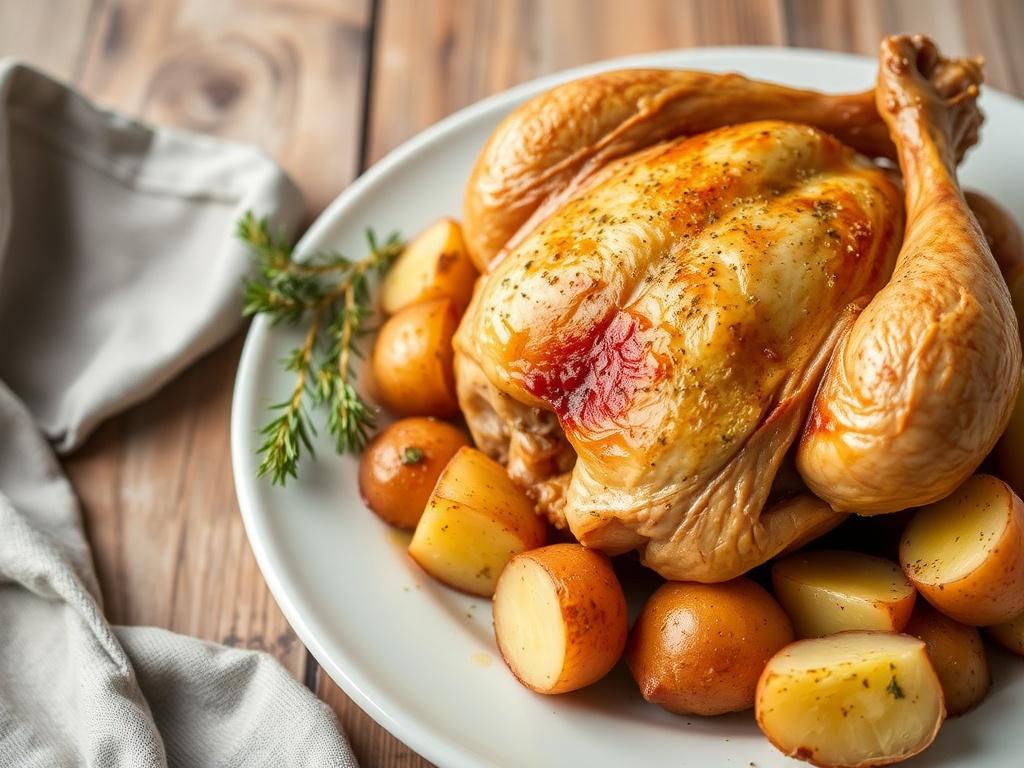
Store leftovers in an airtight container in the refrigerator for up to four days. Separate meat and potatoes if possible to preserve textures; potatoes absorb moisture and soften faster when kept with the meat. To reheat without losing crispness, use a hot oven or an air fryer set to a high temperature for a few minutes — this refreshes the skin and crisps the potato edges. Avoid microwaving if texture matters, unless you plan to finish the pieces under a broiler or in a hot skillet afterward.
Leftover roast chicken is versatile: shred for tacos, fold into a creamy pasta, or toss with a quick curry sauce. Potatoes find second lives as hash with onions and peppers or as a base for a shepherd-style pie. Even the carcass has value: simmering it for stock creates a foundation for soups and risottos. Treat leftovers as planned second meals rather than afterthoughts and you’ll multiply the value of your cooking time.
Wine, beer and drink pairings
Pairing drinks with this dish depends on seasoning and roast intensity. For a lemon-and-herb profile, a crisp white such as Sauvignon Blanc or a light unoaked Chardonnay complements the citrus and cut through the fat. If you go for smoky paprika or a spiced rub, a medium-bodied red like Grenache or a malty amber ale can stand up to the flavors. For richer, butter-based preparations, consider a fuller Chardonnay or a saison beer that offers spice and effervescence to cleanse the palate. Sparkling water with lemon is a simple, elegant non-alcoholic option that refreshes between bites.
When in doubt, choose a beverage with moderate acidity to balance richness. Rosé is remarkably flexible and suits many seasoning approaches, from Mediterranean to North African. Local beers often pair wonderfully with roasted poultry, especially if you prefer casual dinners. Think about how the drink’s weight and acidity will interact with pan juices, potatoes and any added sauces to make a thoughtful match instead of a distracting contrast.
Personal notes from my kitchen
I’ve roasted this meal dozens of times for different audiences: quick weeknight suppers, relaxed Sunday lunches and the occasional small celebration. One memorable evening involved a spatchcocked bird roasted with garlic and preserved lemon while children raced through the garden; the ease with which I carved and served the meal turned a chaotic afternoon into a warm, unhurried dinner. Another time I learned the value of resting when a crowded table nearly derailed the timing — tenting the bird and finishing the potatoes under the broiler saved the day and taught me to plan for buffer time.
My favorite ritual is the pause after removing the chicken from the oven: the house fills with roasted aromas, and preparing the simple pan sauce feels almost ceremonial. Over the years I’ve adapted techniques — sometimes parboiling potatoes for extra creaminess, sometimes rubbing the skin with a paste of butter and crushed garlic for indulgence — but the core idea remains the same. A well-roasted bird and potatoes reward patience and modest effort, and sharing it is one of the easiest ways I know to turn ordinary food into a meaningful meal.
Roasting a whole bird with potatoes is more than a recipe; it’s a practical lesson in timing, texture and flavor balance. With the guidance above you can approach the oven with confidence, adjust for your household’s needs and discover small variations that become your signature. Invite some simple sides, pick a drink that complements the seasonings, and let the oven do the heavy lifting while you enjoy the company around the table. The result will be a satisfying, comforting meal that feels both familiar and special.
